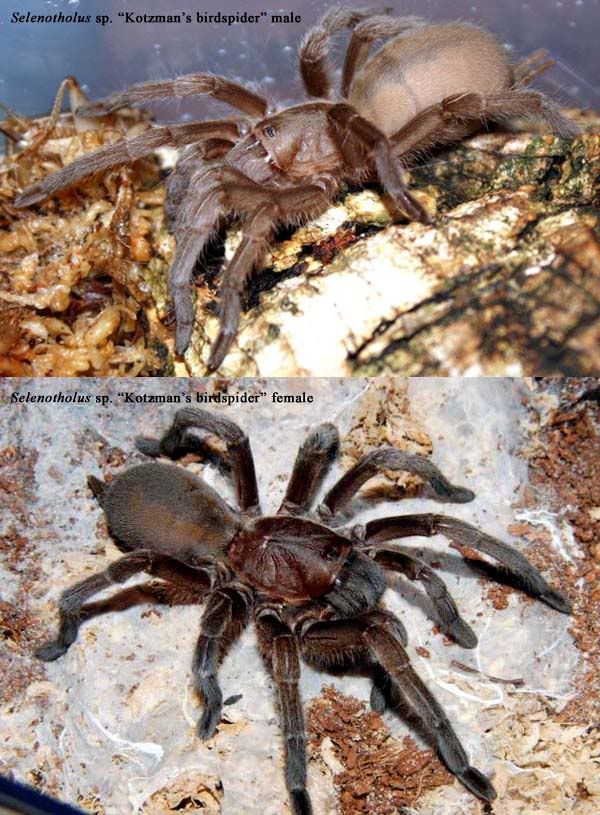I was very fortunate to obtain a tarantula from Greg Bylund late last year which was then identified as an almost mature female
Selenocosmia stirlingi. As luck would have it "she" moulted out to "he" - so much for visually sexing Australian tarantulas! Australian tarantulas are not so easy to sex visually using the standard techniques
(following M.R. Hart) and I have seen mistakes made not infrequently by the very best keepers and collectors. In any case I was happy to have a male and started to look around for a female.
In January 2009 Paul Berg collected what he thought was
Selenocosmia stirlingi in far western New South Wales, Australia and sold a few wild caught specimens into the hobby. Steve Nunn identified these as a new species that showed differences to
S. stirlingi. Steve later identified my male, that was collected close to Paul's collection site, as a member of the same species. The newly recognised species was named by Steve as
Selenotholus sp. "Kotzman's birdspider" after Mandy Kotzman who carried out some valuable research in the 1980's on what turns out is this species of tarantula. True
Selenocosmia stirlingi come from the South Australia/Northern Territory border region which is very distant from the collection sites for the Kotzman's birdspider. Paul's collection site is in fact very close to where Mandy Kotzman conducted her research on this species which she had identified at the time, incorrectly, as
Selenocosmia stirlingi. Mind you that was 20 years ago and a lot has changed with respect to what we know about Australian tarantula's since that time. Enthusiasts will know that the whole Australian taxonomic regime for tarantulas is one huge mess and we are all eagerly waiting for Dr Rob Raven to finish his current review and publish! We have been waiting a long time but no doubt when it is finished it will have been worth the wait.
The Kotzman's birdspider is a true N.S.W.
Selenotholus grassland species with distinct differences to the Queensland
Selenotypus grassland species showing a more rounded, less elongated abdomen and the front legs are thicker than the rear legs just like you see in the yet to be described Australian
Phlogius species.
As luck would have it Heinrich Buys sold me his mature female Kotzman's birdspider recently which was originally collected by Paul Berg so I now have a breeding pair. I am expecting the female to arrive by express post in a few days. The female moulted in February so she is ready for breeding now. A while ago in my blog I listed the species I was breeding this year so this is a very welcome addition to the list. She is about 12 cm in leg span which is probably close to the maximum size of this species.

Selenotholus sp. "Kotzman's birdspider" - my breeding pair. Photo of female by H. Buys. Photo of male by me
I am very excited to have this pair. The male has already built a sperm web and once the female has settled in her new enclosure I will attempt the first Australian mating of this species in captivity. After the male has done his duty with my female I will be forwarding him to Greg Bylund to breed with his females. Greg has 8 mature females ready to go - happy days! With a little luck one of us should be able to have the first captive bred Kotzman's birdspider slings bred and reared in captivity. I'll be putting up some more information about this species after the mating so check back for periodic updates.
Further reading: See Kotzman, M. 1990. Annual activity patterns of the Australian tarantula
Selenocosmia stirlingi (Araneae, Theraphosidae) in an arid area. J. Arachnol.,
18 :123-130.







